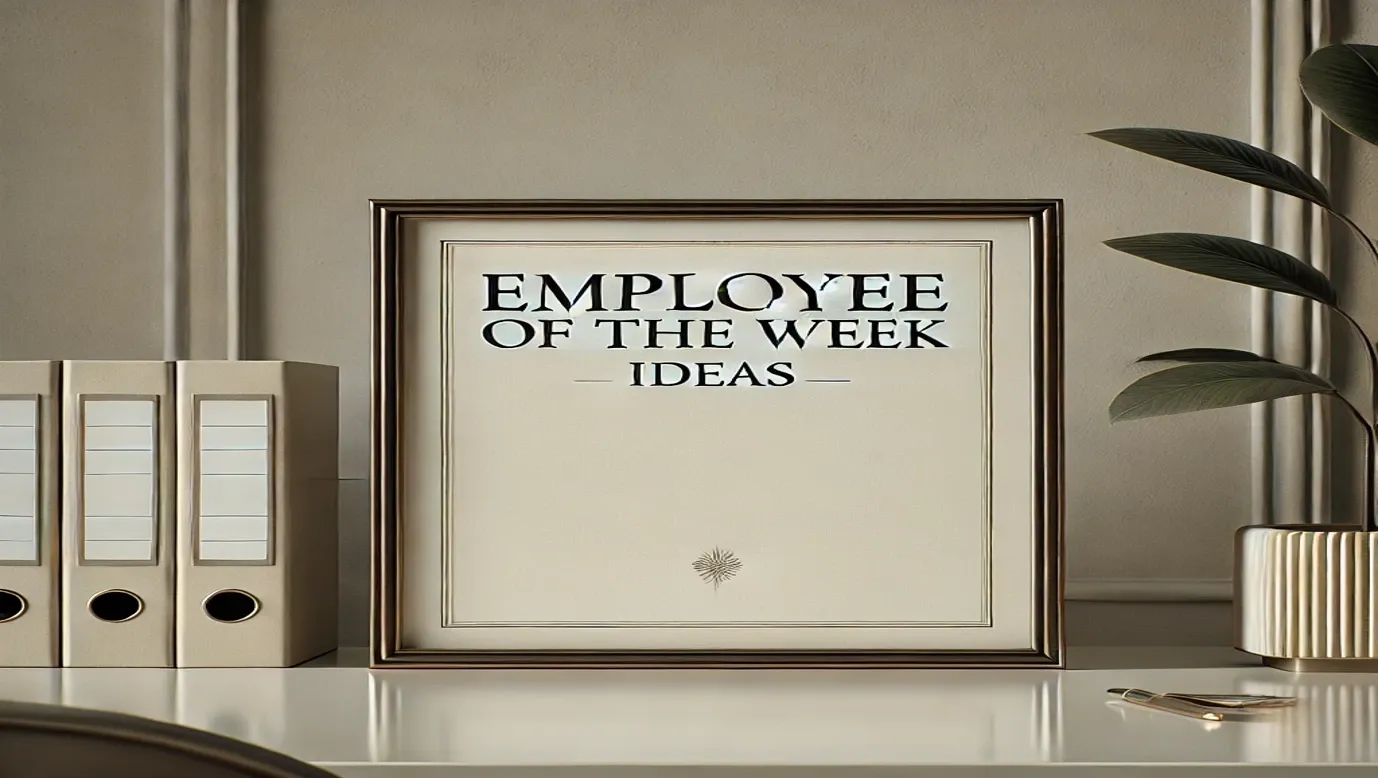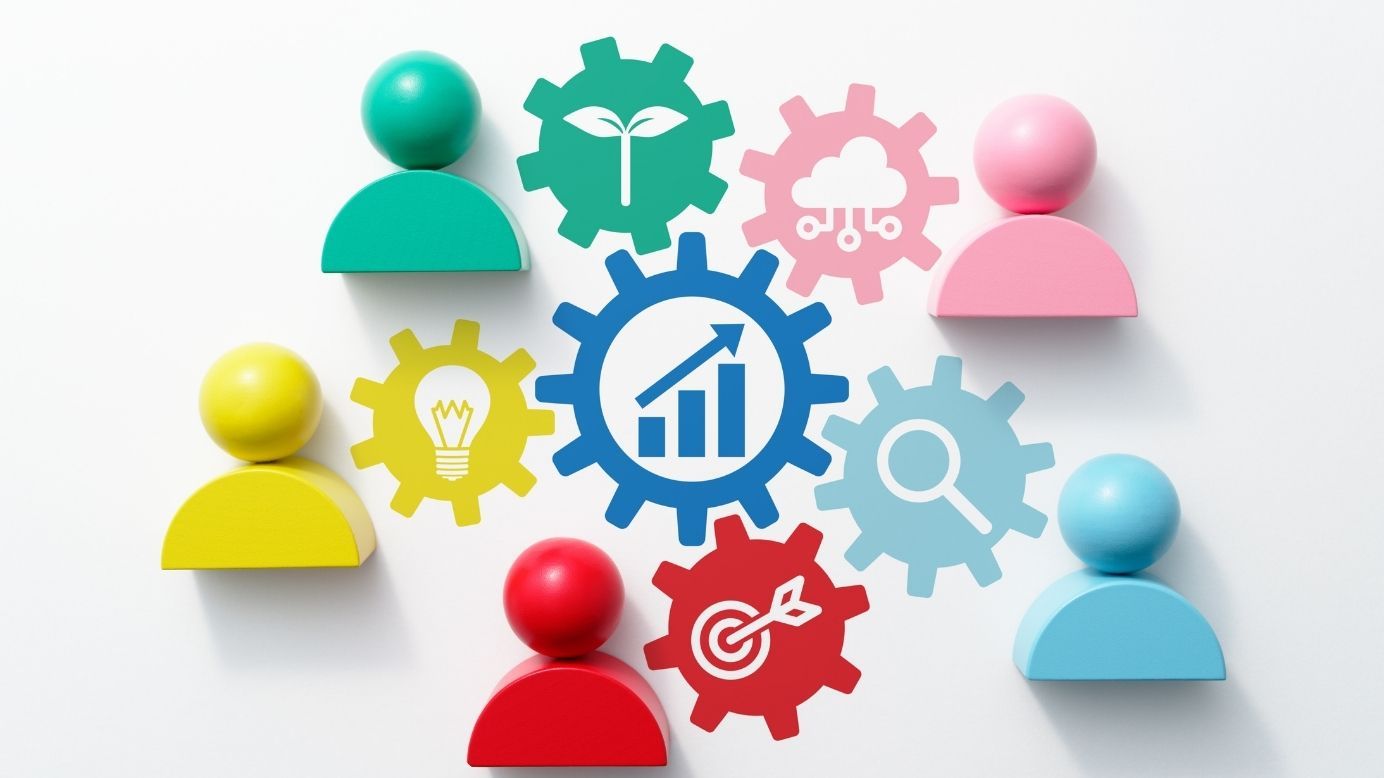
50 هدية مدروسة لتكريم الموظفين في يوم تقدير الموظفين
اكتشف 50 هدية فريدة ومدروسة لتقدير الموظفين للاحتفال بفريقك. من التذكارات الشخصية إلى الهدايا العملية، أظهر امتنانك بشكل هادف.

20 لعبة ممتعة في يوم تقدير الموظفين لرفع الروح المعنوية
اكتشف 20 لعبة ونصائح مثيرة لتقدير الموظفين في يوم تقدير الموظفين لتعزيز روح الفريق وتعزيز التعاون وجعل يوم تقدير الموظفين يوماً لا يُنسى.

50 رسالة شكر لزملاء العمل على هدية الوداع
50 رسالة شكر للزملاء على هدية الوداع للتعبير عن الامتنان القلبي. أقدّر تفانيهم وكرمهم على الهدية المميزة.

35 فعالية يوم تقدير الموظف وموضوعات الحفلات التي يجب مراعاتها في عام 2025
اكتشف 35 موضوعًا ملهمًا لتقدير الموظفين لعام 2025، بدءًا من الفعاليات الممتعة إلى اللفتات المدروسة، للاحتفال بفريقك ورفع الروح المعنوية في مكان العمل.

أكثر من 10 أفكار مبتكرة لجوائز سنوات الخدمة الإبداعية لكل مرحلة من مراحل الخدمة
استكشف أفكار جوائز سنوات الخدمة الفريدة من نوعها للاحتفال بالمراحل الهامة مثل 1 و5 و10 و20 عاماً. عزز الولاء والروح المعنوية والمشاركة مع الجوائز الشخصية.

50 فكرة مبتكرة لحوافز الموظفين في عام 2025 لتعزيز مشاركة الموظفين
اكتشف 50 برنامجاً مبتكراً لتحفيز الموظفين لرفع الروح المعنوية وتحسين الإنتاجية وتعزيز الثقافة الإيجابية في مكان العمل.

5 استراتيجيات فعالة مستقاة من أفضل 4 شركات في مجال الاستثمار المباشر
استكشف أهمية شركات مبادرة التنوع والشمول في تعزيز ثقافة مكان العمل. تعلم استراتيجيات تنفيذ مبادرات التنوع والمساواة والشمول.

12 فكرة لتكريم الجوائز لتعزيز مشاركة الموظفين وولائهم
استكشف الجوائز التقديرية لتعزيز مشاركة الموظفين. اكتشف الأمثلة ونفّذ البرامج التي تعزز التحفيز والإنتاجية في مؤسستك.

30 هدية تقدير فريدة من نوعها للموظفين لتشعرهم بالتقدير والتقدير
أظهر تقديرك لموظفيك بهدايا التقدير. اكتشف طرقاً مبتكرة وذات مغزى لتقدير ومكافأة فريقك على عمله الجاد وتفانيه.

كيف يمكن لبرامج الولاء الفعالة للموظفين أن تحول مؤسستك إلى الأفضل
اكتشف برامج الولاء الفعّالة للموظفين التي تعزز الاحتفاظ بالموظفين وترفع الروح المعنوية وتعزز الثقافة الإيجابية في مكان العمل. استكشف الأنواع والمزايا واستراتيجيات التنفيذ.

10 أفكار مؤثرة لشارات تقدير الموظفين لتعزيز المشاركة
اكتشف قوة شارات تقدير الموظفين في تعزيز ثقافة مكان العمل. اكتشف الأنواع والمزايا والبرامج الناجحة التي تحتفي بالإنجازات وتعزز الروح المعنوية والمشاركة والاحتفاظ بالموظفين.

دليل إجراء استبيانات العودة إلى المكتب لجمع آراء الموظفين بشكل فعال
اكتشف كيفية إجراء استبيان العودة إلى العمل بفعالية لقياس مشاعر الموظفين وتفضيلاتهم. تعرّف على أفضل الممارسات، والأسئلة الرئيسية التي يجب طرحها، وكيف يمكن لمنصات مثل Empuls تحويل التعليقات إلى رؤى قابلة للتنفيذ، مما يضمن الانتقال السلس إلى مكان العمل.

استطلاعات رأي الموظفين: دليل لفهم احتياجات فريقك: دليل لفهم احتياجات فريقك
اكتشف كيف يمكن لاستطلاعات رأي الموظفين تعزيز المشاركة والإنتاجية من خلال جمع رؤى حول معنويات فريقك ورضاه في مكان العمل.

برامج بطاقات هدايا الموظفين: المفتاح لإشراك ومكافأة القوى العاملة لديك
اكتشف كيف تعمل برامج بطاقات هدايا الموظفين على تعزيز الروح المعنوية، وتقديم مكافآت مخصصة، وتحسين ثقافة مكان العمل من خلال سهولة التنفيذ. تعرّف على الأنواع والفوائد وأفضل الممارسات.

10 أفكار مبتكرة لموظف الأسبوع المبدع التي تحدث تأثيراً حقيقياً
اكتشف أفكارًا مبتكرة وجذابة لموظف الأسبوع لتعزيز الروح المعنوية والتحفيز في فريقك. تعلم كيفية تنفيذ البرنامج والحفاظ عليه بفعالية باستخدام أدوات مثل Empuls.

جوائز إشراك الموظفين: الأنواع والأمثلة وأفضل الممارسات التي تنجح بالفعل
تعرّف على تأثير جوائز مشاركة الموظفين وكيفية تعزيزها للروح المعنوية وتحسين الإنتاجية وتقوية ثقافة مكان العمل من خلال أمثلة واقعية من الشركة.

استبيان رضا الموظفين عن الشركات للحصول على رؤى دقيقة
شركات استبيان رضا الموظفين: اكتشف أفضل مقدمي الخدمات الذين يقدمون رؤى قابلة للتنفيذ لتعزيز رضا الموظفين في مكان العمل.

كيفية بناء خطة لتقدير الموظفين تنجح بالفعل
تعرّف على كيفية وضع خطة فعّالة لتقدير الموظفين تعزز الروح المعنوية والمشاركة والإنتاجية. استكشف المكونات الرئيسية وخطوات التنفيذ، وشاهد أمثلة واقعية من أفضل الشركات.

كيف يمكن لجوائز الشركة التقديرية أن تعزز مشاركة الموظفين ومعنوياتهم؟
تقدم جوائز تقدير الشركات رؤى قيمة حول الفوائد وأفضل الممارسات والأفكار المبتكرة لتقدير الموظفين ومكافأتهم.

كيف تساعد استطلاعات تفاعل الأشخاص الفريق على تعزيز المشاركة؟
يساعدك دليلنا لاستطلاعات مشاركة الموظفين على قياس مشاركة الموظفين، وتصميم الاستطلاعات، وطرح الأسئلة، واختيار أفضل البرامج.

برامج الاستماع للموظفين: لماذا تحتاج كل شركة إلى واحد
يمكن لبرامج الاستماع للموظفين تحويل الملاحظات إلى أفعال. اكتشف أنواعها وفوائدها وخطوات تنفيذ برنامج ناجح لتحقيق تأثير دائم.

أفضل 20 امتيازات الشركة للموظفين
أفضل امتيازات الشركة للموظفين: اكتشف 20 ميزة يمكن أن ترفع مستوى رضا الموظفين وتعزز مشاركتهم وتقوي الاحتفاظ بهم في مؤسستك.

مكافآت وحوافز الموظفين - التأثير النفسي للموظفين
مكافآت وحوافز الموظفين هي مفتاح بناء الشركات الناجحة. فهي تحفز وتحسن الأداء وتعزز ولاء الموظفين تجاه الشركة.

أفضل 15 هدية لإشراك الموظفين لعام 2024
هدايا مشاركة الموظفين الملهمة والمحفزة: استكشف أفكاراً مبتكرة لهدايا مشاركة الموظفين لتعزيز معنويات الفريق ورضاه.

أساسيات برنامج جائزة الخدمة: ما الذي يجب على كل شركة مراعاته
برنامج جائزة الخدمة: استكشف كيفية تصميم برامج ناجحة لجوائز الخدمة المؤسسية، بما في ذلك المزايا والأفكار الرئيسية لتكريم المعالم البارزة.

تقنيات إشراك الموظفين: من النظرية إلى التطبيق في مكان العمل اليوم
تقنيات وأدوات واستراتيجيات إشراك الموظفين لتعزيز إنتاجية القوى العاملة ورضاهم ونجاح المؤسسة.

28 فكرة مدروسة لهدايا الذكرى السنوية للعمل تناسب كل مرحلة من مراحل العمل
تقدم هدايا الذكرى السنوية لعمل الموظف العديد من المزايا مع اختيار أفكار هدايا مبتكرة للذكرى السنوية لعمل الموظف. إنشاء برامج هدايا فعالة لهدايا الموظفين.

برنامج جوائز الموظفين: أفضل الممارسات والنصائح
اكتشف أهمية برامج جوائز الموظفين، واستكشف أنواعاً مختلفة منها، وتعرّف على أفضل الممارسات لتقدير وتحفيز فريقك بفعالية. عزز الروح المعنوية والاحتفاظ بالموظفين وثقافة الشركة من خلال برنامج تقدير مصمم بشكل جيد.

أفضل 10 منتجات لتقدير الموظفين يجب أن تعرفها في عام 2025
استخدم منتجات تقدير الموظفين لرفع الروح المعنوية وتعزيز الإنتاجية. تعرّف على كيفية تنفيذها بفعالية لتحقيق أقصى قدر من التأثير.

برامج جوائز خدمة الموظفين: دليل (2024)
برامج مكافآت خدمة الموظفين استراتيجيات فعالة في عام 2024. تعزيز التقدير، وأتمتة المكافآت، وتعزيز المشاركة للاحتفاظ بأفضل المواهب.

ثورة المكافآت والتقدير: الكشف عن تفضيلات الموظفين في عام 2025
يغطي تقرير اتجاهات التقدير والمكافآت Empuls تقرير اتجاهات التقدير والمكافآت لعام 2024 تصميم أطر التقدير، والموازنة بين المكافآت النقدية وغير النقدية، والاحتفال برحلة الموظف.

6 أفكار ربع سنوية للمكافآت والتقدير لتنفيذها في عام 2025
اكتشف كيف يمكن للمكافآت والتقديرات الفصلية أن تعزز معنويات الموظفين وتحفزهم وإنتاجيتهم وإدارتهم.

صافي نقاط المروجين لمشاركة الموظفين لتعزيز الرضا في مكان العمل
اكتشف كيفية استخدام صافي نقاط المروّج لتحسين مشاركة الموظفين. تعرّف على المزايا وخطوات التنفيذ، واستخدم eNPS لتحسين الرضا والإنتاجية في مكان العمل.

15 فكرة لحافز المكافأة للموظفين
15 حافزًا لمكافأة الموظفين لتعزيز المشاركة والتحفيز. عزز الروح المعنوية من خلال أفكار التقدير الهادفة والفعالة.

12 برنامجاً لتقدير الموظفين مع أفضل الممارسات والاستراتيجيات
اكتشف 12 برنامجاً فعّالاً لتقدير الموظفين وأفضل الممارسات لتعزيز المشاركة والروح المعنوية والإنتاجية بأفكار واستراتيجيات مبتكرة.

أفضل 12 حلاً لتجربة الموظفين في عام 2024
تعمل حلول تجربة الموظفين على تعزيز الإنتاجية، وتحسين الأداء، وتوفير ثقافة جيدة للشركة. فيما يلي قائمة بـ 12 حلاً لتجربة الموظف.

دليل لفهم مكافآت ومزايا التقاعد مع مراجع Fortune 500
مكافآت التقاعد هي حوافز يقدمها أصحاب العمل لتقدير ودعم الموظفين مع اقترابهم من التقاعد ودخولهم فيه.

دليل تطوير ثقافة الشركة الإيجابية
يمكن لثقافة الشركة تنشيط جهود المؤسسة للحفاظ على سعادة الموظفين وإنتاجيتهم. تعرّف على أهميتها وطرق تطويرها وتقييمها.

أنواع برامج تقدير الموظفين التي سيتم تشغيلها في عام 2024
برامج تقدير الموظفين هي حل جيد للشركات التي تتطلع إلى الاحتفاظ بالقوى العاملة لديها. تعرّف على الأنواع المختلفة لبرامج التقدير في عام 2024

دليل قيادة تقدير الموظفين
تقدير الموظفين له قيمة كبيرة في توحيد المؤسسة. تعرّف على أهمية تقدير الموظفين واختلافه في التقدير

14 فكرة لبناء الفريق بميزانية محدودة لتعزيز وحدة الفريق
يمكن أن تكون أفكار بناء الفريق طريقة ممتعة للابتعاد عن الروتين والتواصل مع الزملاء على مستوى شخصي أكثر. اطلع على 14 مبادرة لبناء الفريق بميزانية منخفضة لكسر الجليد بين الزملاء وتحسين تفاعلهم.

4 تجارب بناء فريق العمل لتكوين فريق عمل متناغم
تساعد تجربة بناء فريق العمل المؤسسات على خلق ثقافة إيجابية للشركة، ومواءمة الموظفين مع القيم المشتركة، وتحسين التواصل بين الموظفين.

برنامج مكافآت الموظفين: 5 أفكار فريدة من نوعها مع أمثلة لتوليد المشاركة والرضا
يشير برنامج مكافآت الموظفين إلى مبادرة مصممة لتكريم الموظفين على مساهماتهم في الشركة من أجل المشاركة والرضا.

استبيان الموظفين: ما يجب فعله وما لا يجب فعله وأفضل الممارسات
استبيان الموظفين هو أداة تنظيمية تهدف إلى جمع آراء الموظفين حول تجربتهم في العمل.

أفضل 10 شركات لإشراك الموظفين تطلق العنان لإمكانات القوى العاملة لديك
الاستثمار في مشاركة الموظفين يؤتي ثماره! استكشف أفضل 10 شركات لديها حلول مثبتة لتعزيز السعادة والاحتفاظ بالموظفين والعائد على الاستثمار.

اتجاهات الموارد البشرية في عام 2024: الإبحار في مستقبل العمل
استكشف أحدث اتجاهات الموارد البشرية التي تشكل أماكن العمل في عام 2024 وتعرف على كيفية التنقل في المشهد المتطور لمستقبل العمل من خلال استراتيجيات مبتكرة.

25 فكرة لتقدير الموظفين ستجعلك متميزاً في عام 2025
تعرَّف على 25 فكرة لتقدير الموظفين ستساعدك على تحسين الروح المعنوية وتحفيز فريقك وتعزيز ثقافة العمل الإيجابية لتحقيق النجاح المؤسسي في عام 2025.

4 فوائد لمكافآت الموظفين للأعمال التجارية وأمثلة على الشركات التي تنفذها
إذا لم تكن المكافآت ساحرة وليس لها صدى لدى الموظفين ، فلن تصل برامج المكافآت إلى الأرض أبدا.

30 فكرة لمكافأة الموظفين ترفع الروح المعنوية وتبني فرقا مزدهرة
استكشف قائمة منسقة من 30 فكرة إبداعية لمكافأة الموظفين مصممة لرفع الروح المعنوية وتعزيز ثقافة مكان العمل الإيجابية. اقرأ الآن.

مكافآت المستقلين: دليل لتمكين العمال المستقلين
لماذا تحتاج إلى مكافأة العاملين لحسابهم الخاص تماما كما تكافئ موظفيك. من المهم أن تبدأ في مكافأة المستقلين الذين يقيمون علاقة مع المستقل

كيف تهديني الوقت لموظفيك
امنح Me-Time لموظفيك حيث يمكنهم كسر رتابة جدولهم الروتيني والانغماس في الأعمال التي تجعلهم سعداء.

تجارب المكافآت كخيار لبرنامج مكافآت الموظفين
الشيء المثير للاهتمام حول التجارب كمكافآت هو تأثيرها الفريد ، كحافز وأداة للمشاركة الخبرات ومغامرات الاحتفاظ

30 لعبة بناء فريق جذابة لتعزيز التعاون والتواصل
30 لعبة تفاعلية لبناء الفريق للعمل تعزز التعاون وتعزز إحساسا أقوى بالوحدة داخل فريقك. ارتق بديناميكيات فريقك الآن.

أفضل 8 حلول لمنصة تجربة الموظفين لعام 2025 (+ نصائح حول اختيار الحل المناسب)
عند اختيار منصة تجربة الموظف ، لا يمكنك أن تخطئ في حل يقدم مجموعة مختارة من الميزات بشكل خاص. فيما يلي الدليل الكامل لمساعدتك في اختيار منصة تجربة الموظف المناسبة.

قواعد مشاركة الموظفين: كيفية كسب الحرب ضد استنزاف الموظفين
مشاركة الموظفين أمر بالغ الأهمية للاحتفاظ والنجاح. ابق على اطلاع ، وتواصل ، وافهم مستقبل صاحب العمل ، واطلب التكيف لتجنب الاستنزاف المرتفع.

12 ركيزة أساسية لتجربة الموظف في مكان العمل
تجربة الموظف (EX) هي جانب حاسم من جوانب مكان العمل الحديث الذي تم تحويله منذ إنشائه قبل سنوات. وبالتالي ، من الضروري فهم ركائز تجربة الموظف وتصميم استراتيجية تجربة مقنعة للازدهار في سوق تنافسية.

لماذا تعتبر تجربة الموظف مهمة وما هي نتائجها
تجربة الموظف ليست مجرد كلمة طنانة أو مصطلح تسويقي. إنها مفتاح نجاحك. إليك 10 أسباب لأهمية تجربة الموظف.

التواصل مع الموظفين: تعريفه وأنواعه
في جوهرها ، التواصل بين الموظفين هو عملية نقل المعلومات والأفكار من شخص إلى آخر داخل المنظمة ، لكنه يتجاوز ذلك. إنه يعكس قيم شركتك وأيديولوجياتها وثقافتها. كشف النقاب عن معناها الحقيقي ومعرفة أنواعها والغرض منها بشكل أفضل.

ما هي ركائز التواصل الفعال في مكان العمل
في جوهرها ، يتعلق التواصل الفعال في مكان العمل بفهم جمهورك والتعاطف معه. لجعل استراتيجية الاتصال الخاصة بك والحل والتآزر تتماشى مع بعضها البعض ، تأكد من التركيز على هذه الركائز: الاستماع والمشاركة والاتصال والإلهام والتوجيه.

مهارات التعامل مع الآخرين: أهميتها وأنواعها وطرق تحسينها
مهارات التعامل مع الآخرين هي المهارات التي تستخدمها للتفاعل مع الآخرين. وهي تشمل مهارات التواصل وحل المشكلات والتفاوض. اقرأ هذه المدونة لفهم خمسة عشر نوعا وخمس طرق فعالة لتحسين مهارات التعامل مع الآخرين في مكان العمل.

كيفية قياس عائد الاستثمار على مبادرات تجربة الموظف
على الرغم من حقيقة أن المزيد والمزيد من الشركات بدأت ترى القيمة في مبادرات تجربة الموظفين ، إلا أن الكثيرين ما زالوا غير متأكدين من كيفية قياس العائد على الاستثمار (ROI) لهذه البرامج. سيساعدك هذا الدليل على القيام بذلك.

أمثلة على تجربة الموظف: 9 شركات تقدم تجربة رائعة في مكان العمل
إذا كانت بعض الأمثلة الجيدة على تجربة الموظف هي ما تبحث عنه ، فقد وصلت إلى الصفحة الصحيحة. لقد قمنا بتنسيق قائمة بأفضل الشركات التي تقطع شوطا إضافيا في ضمان تجربة رائعة للموظفين في مكان العمل. تعلم الأسرار منهم للحفاظ على شعبك سعيدا ومنتجا.

ما هي تجربة الموظف والمراحل المختلفة التي تنطوي عليها
قبل أن تتعرف على تجربة الموظف والمراحل المختلفة لتجربة الموظف بعمق ، دعنا نفهم المصطلح بكلمات بسيطة. تجربة الموظف هي الرحلة التي يأخذها الموظف مع المؤسسة ، بدءا من التوظيف إلى الصعود إلى التفاعلات التي يتعين عليهم الخروج منها.

فهم نموذج جبل الجليد الثقافي لدفع النجاح التنظيمي
في عام 1976 ، طور إدوارد تي هول "نموذج جبل الجليد للثقافة" وأوضح أن الثقافة التنظيمية تشبه جبل جليدي موجود في البحار القطبية. ما تراه هو مجرد غيض من فيض. تحتها كتلة هائلة غير مرئية ، والتي تمسك كل شيء معا بقوة.

كيفية قيادة تجربة الموظف الرائعة التي تؤدي إلى تجربة عملاء ممتازة
لا تعزز تجارب الموظفين الرائعة إنتاجية القوى العاملة لديك فحسب ، بل توفر أيضا تجربة عملاء ممتازة. إليك كيفية تقديم تجربة رائعة للموظفين.

لماذا تعتبر مكافآت الموظفين وتقديرهم مهمة ، وكيف تؤثر بشكل إيجابي على المنظمة
تعد مكافآت الموظفين وتقديرهم أمرا مهما لتحسين القيم التنظيمية وسعادة الموظفين وزيادة رضا العملاء وتحفيز الموظفين على بذل المزيد من الجهد. لذلك دعونا نفهم فوائد مكافآت الموظفين وتقديرهم وكيف تؤثر بشكل إيجابي على المؤسسة.

متى تبدأ التخطيط لبرنامج مكافآت الموظفين وتقديرهم
يقولون ، اضرب بينما الحديد ساخن. ولكن كيف تقرر الوقت المناسب لضرب برنامج مكافآت وتقدير موظفيك؟ لمساعدتك في ذلك ، إليك خطة عمل جيدة التخطيط وتنفيذها بحذر تضمن الإطلاق والمشاركة الناجحين لبرنامج البحث والتطوير الخاص بك.

كيفية قياس عائد الاستثمار وفعالية برنامج تقدير الموظفين الخاص بك
يقولون أن شيئا لا يمكن قياسه لا يمكن إدارته. التمسك بهذا البيان ، يصبح من الضروري قياس فعالية برامج تقدير الموظفين. عند تنفيذها وفقا للمعايير الصحيحة ، فإنها تكشف الكثير عن إنتاجية موظفيك ومستوى التزامهم والمزيد.

أهمية وفوائد مشاركة الموظفين: لماذا هو مفتاح نجاح الأعمال
تعد مشاركة الموظفين أمرا حيويا لنجاح الشركة ، وتعزيز تجربة الموظف الإيجابية ، والسعادة ، والرضا ، والاحتفاظ ، وانخفاض معدل دوران الموظفين ، وتعزيز الإنتاجية التنظيمية.

كيفية تحسين تجربة الموظف من خلال مجموع المكافآت
تصف تجربة الموظف كيف يشعر الموظفون تجاه العوامل التنظيمية المختلفة والمكافآت الإجمالية تساعد على إحداث ثورة في تجربة الموظف. لذا إليك المخطط لتحسين تجربة الموظف من خلال المكافآت الإجمالية.

ما هي مكافآت الموظفين والتقدير؟
المكافأة والتقدير هو نظام يتم فيه الاعتراف بالأشخاص لأدائهم وسلوكياتهم بطرق جوهرية أو خارجية. اقرأ هذه المدونة لفهم المعنى والاختلافات بين مكافآت الموظفين وتقديرهم وكيف يمكنهم معا مساعدتك في بناء ثقافة عمل رائعة.

تقدير الموظف: التعريف والأنواع والأهمية والأفكار
تقدير الموظفين يعزز الاحتفاظ بالموظفين والإنتاجية. اكتشف فوائده وأفكاره لتقدير مساهمات فريقك القيّمة.

التواصل بنجاح مع إطلاق برنامج تقدير الموظفين الخاص بك
خطة التواصل والترويج الفعالة هي كل ما تحتاجه لإطلاق برنامج الاعتراف الخاص بك بنجاح. هذا الدليل سوف يأخذك من خلال واحد.

ما هو الفرق بين المزايا والامتيازات والهدايا والجوائز والحوافز والمكافآت؟
افهم الفرق بين المزايا والامتيازات والهدايا والحوافز والجوائز والمكافآت لإنشاء المزيج المناسب لجذب أفضل مواهبك والاحتفاظ بها وإشراكها.

30 برنامج تحفيز للموظفين يجب التفكير في تشغيلها في عام 2025 من أجل مشاركة أفضل
اكتشف 30 برنامجاً فعالاً لتحفيز الموظفين لتعزيز المشاركة والأداء. اكتشف استراتيجيات لفرق العمل عن بُعد وقياس نجاح برنامجك.

التنوع والشمول في مكان العمل: الفوائد ولماذا يهم
لماذا التنوع والشمول في مكان العمل مهمان؟ حسنا ، هناك أكثر مما تراه العين. إليك سبب أهمية الشمولية الثقافية في مكان العمل.

7 أخطاء يجب تجنبها أثناء عملية ملاحظات الموظفين
يمكن لعملية ملاحظات الموظفين أن تجعل أو تكسر مستوى العقل في مؤسستك. تجنب هذه الأخطاء ومهد الطريق للنجاح.

كيف تكون مديرا فعالا في عام 2024؟
يمكن للمديرين المساعدة في إطلاق العنان للأفضل في موظفيهم. ولكن ما الذي يجعل المدير الاستثنائي استثنائيا مقارنة بالمدير العادي؟ إليك كيفية القيام بذلك.

عملية من ثلاث خطوات لإنشاء هدف تقديم ثقافة الشركة
ثقافة الشركة العظيمة تولد موظفين رائعين. الثقافة التي تركز على مزايا الموظفين ورفاهيتهم تؤدي إلى أداء ممتاز للموظفين.

استخدام التلعيب لتحسين مشاركة الموظفين وتجربتهم في عام 2025
اكتشف كيف يعمل استخدام Gamification على تحسين مشاركة الموظفين لمساعدة المؤسسات على إنشاء بيئات عمل عالية الكفاءة.

كيف يعزز العطاء في مكان العمل والعمل الخيري للشركات المشاركة والنوايا الحسنة للصناعة
كيف يجعل العطاء في مكان العمل وبرامج العمل الخيري للشركات الشركات أكثر ثراء بأصول فريدة - مثل الموظفين المشاركين ، والنوايا الحسنة في الصناعة ، والعلامة التجارية لصاحب العمل المقنع.

ما هي الثقافة التنظيمية: جين المحرك الخاص بك
دعونا نعيد تصور الأعمال التجارية من أجل عالم أعيد تشغيله من خلال تنظيف ما قد يكون أقوى رأس مال لها ، الثقافة التنظيمية.

أبطال Healing Healthcare: مكافآت وتقدير للممرضات والأطباء وغيرهم من العاملين في مجال الرعاية الصحية في الخطوط الأمامية
خلال هذه الأوقات الصعبة، يجب على القادة التدخل لمساعدة موظفي الرعاية الصحية في الخطوط الأمامية على التعافي - من خلال إطلاق العنان للتقدير والمكافآت ذات المغزى.

Employee Net Promoter Score: The Guide to What, Why, and How of eNPS
Employee net promoter score (eNPS) is a simple yet powerful metric to measure employee satisfaction and engagement. In this guide, we explore how eNPS works, its benefits, and how companies can leverage it to create a more engaged workforce.

كيفية كتابة خطاب تقدير الموظف المثالي [+ 6 قوالب]
تقدير الموظفين يعزز المشاعر الإيجابية ويعزز دوافعهم. فيما يلي 6 خطابات تقدير للموظفين لموظفيك.

برامج الدفاع عن الموظفين لعام 2024: حول موظفيك إلى معجبين متميزين
يعمل الموظفون من أجلهم. يعمل المشجعون من أجلك. مع برامج الدفاع عن الموظفين، تألق أكثر إشراقا أمام العالم من خلال بناء التعلق في موظفيك وعمالك.

من الموارد البشرية إلى البشر ذوي الحيلة: كيفية بناء ثقافة تنظيمية قوية؟
بناء ثقافة تنظيمية قوية هو فن. إليك كيف يمكنك إتقان فن بناء ثقافة تنظيمية قوية في 8 خطوات سهلة.

من سيدافع عن R & R الموظف في مكان العمل الرقمي؟
في مكان العمل 4.0 ، يساعد برنامج البحث والتطوير الرقمي على جذب أفضل المواهب والاحتفاظ بها. يجب أن يكون هذا البرنامج مدفوعا بلجنة مخصصة للبحث والتطوير ، بالتعاون مع المديرين والموظفين ، بينما تتولى الموارد البشرية دور التمكين. اقرأ المزيد في المدونة.

Employee Engagement Surveys: How to Capture Genuine Feedback
An employee engagement survey is a powerful tool for understanding workplace sentiment and improving employee experience. But gathering feedback is just the first step—knowing how to communicate employee engagement survey results effectively ensures insights lead to real change.

الوصفة المثالية لبرنامج اقتراحات الموظفين: من صندوق إلى قاعة الاجتماعات
صناديق الاقتراحات ميتة ، لكن برامج اقتراحات الموظفين تعيش كأداة عالية الإنتاجية. إليك كيف يمكن للإدارة إنقاذ أموال كبيرة منه.

30 فكرة لتكريم الموظفين لتجربتها مع الأقران والأفراد والفرق في عام 2025
إن بناء ثقافة الاعتراف يساعد الناس على الشعور بالتقدير، مما يؤدي إلى الالتزام والمساءلة ويخلق شعورا بالرضا. بالنظر إلى مدى أهمية التعرف على الموظفين ، إليك عشر أفكار إبداعية للاعتراف بالموظفين من أجل أجواء مكان عمل سعيدة.

3 نصائح أكثر فعالية حول كيفية أن تصبح رئيسا رائعا
اكتشف كيف تصبح مديرا جيدا مع Empuls - احصل على المزيد من التحفيز والمزيد من المشاركة والمزيد من الأداء من موظفيك وفرقك كل يوم!

كيفية منع الإرهاق الموظف بسبب التواصل المفرط؟
كل شيء ، عندما يتم ذلك بشكل زائد ، سيء. اقرأ هذه المدونة لمعرفة كيفية منع إرهاق الموظفين بسبب فرط التواصل.

دور القائد في بناء الثقافة التنظيمية
يلعب القادة دورا حيويا في بناء ثقافة المنظمة. خذ إشارة من مارك زوكربيرج وستيف جوبز ، ستوضح هذه المدونة دور القائد في تحديد ثقافة المنظمة.

لماذا تعتبر مشاركة الرؤية التنظيمية مهمة؟
اكتشف كيف خلقت الرؤية التنظيمية المشتركة التآزر وتساعد الفريق على أن يصبح أكثر من أجزائه.

كيفية اختيار منصة مكافآت وتقدير الموظفين المناسبة؟
عند اختيار منصة مكافأة وتقدير الموظفين ، لا يمكنك أن تخطئ في حل يقدم مجموعة مختارة من الميزات بشكل خاص.

ما هي العلاقة بين شوكولاتة الكراميل المملحة والثقافة والخبرة والمشاركة والتحفيز؟
الاختلافات بين الثقافة والخبرة ومشاركة الموظفين والتحفيز مربكة. ماذا عن شوكولاتة الكراميل المملحة؟

أنشطة التنوع والشمول في مكان العمل
زيادة الإنتاجية والسعادة مع هذه الأنشطة التنوع والشمول لعملك. استخدم هذه الطرق لنقل عملك إلى المستوى التالي.

6 شركات ذات ثقافة تنظيمية رائعة
الثقافة التنظيمية القوية ليست خيارا، واتباع خطى هذه الشركات الست ذات الثقافة التنظيمية الكبيرة سيساعدك على بناء واحدة.

14 شركة لديها أفضل 14 برنامجاً لتكريم الموظفين المتميزين
اكتشف أفضل 14 شركة لديها أفضل 14 برنامجاً لتقدير الموظفين! من شركات التكنولوجيا العملاقة إلى الشركات الناشئة، استكشف الأساليب المبتكرة لمكافأة الموظفين وتقدير عملهم الجاد. تعرّف على كيفية مساهمة هذه البرامج في تحقيق النجاح وتنمية ثقافات مزدهرة في مكان العمل.

ترك الماضي وراءنا: نقلة نوعية في برامج البحث والتطوير
إليك كيف أن التحول من المكافآت التقليدية إلى المكافآت الحديثة يغذي القوى العاملة الحديثة ويفوز بالدعم.

لماذا تعتبر الثقافة التنظيمية مهمة؟
لماذا تحتاج شركتك وفرقك إلى ثقافة متوائمة ومستدامة لرفع مستوى لعبتهم وممارسة رياضتهم؟ هنا هو السبب.

ما هي المكافآت الإجمالية: إليك نظرة شاملة
أعد تعريف استراتيجية المكافآت الإجمالية الخاصة بك لتحفيز الجذب والاحتفاظ ومشاركة الموظفين ، وقد تفوز بجائزة "أفضل مكان عمل"!

5 استراتيجيات فريدة لإشراك الموظفين لنشرها في عام 2025
ستعمل استراتيجيات إشراك الموظفين الفريدة هذه على زيادة الإنتاجية وتقليل معدل الدوران وضمان النجاح.

إحصائيات مشاركة الموظفين الرئيسية لبناء قوة عمل سعيدة في عام 2025
تزيد مشاركة الموظفين من الإنتاجية وتقلل من معدل الدوران. تحقق من هذه الإحصاءات الصادمة لمشاركة الموظفين ال 15 التي نراهن على أنك لن تعرفها.

الركائز ال 10 لمشاركة الموظفين في عام 2024
تتعلق مشاركة الموظفين بفهم الأشخاص وتحفيزهم وربطهم. فيما يلي 10 ركائز لمشاركة الموظفين من أجل قوة عاملة أكثر سعادة وإمكانات أعلى وأكثر إنتاجية.

مكافآت الموظفين: نفقات تقديرية أم استثمار لا غنى عنه؟
مكافآت الموظفين هي هدية رائعة مغلفة بذوق التقدير ، ولكن هل هناك حاجة إليها حقا؟ هل يمكن تخطيها؟ دعونا معرفة الواقع.

الإدارة الجزئية في مكان العمل: التعريف والأمثلة والآثار الضارة
الإدارة الجزئية في مكان العمل تضر أكثر مما تعود بالنفع على الشركات. تعرف على سبب عدم كونها سمة شائعة في المديرين.

الاستماع النشط في مكان العمل: لماذا يهم وكيفية القيام بذلك
يتضمن الاستماع النشط حقا سماع ما يقوله الناس وفهم أفكارهم ومشاعرهم أثناء المحادثة. استكشف مدونتنا للكشف عن بعض تقنيات الاستماع النشطة المجربة والمختبرة.

الدور المتطور للموارد البشرية في إشراك الموظفين
يعمل الموارد البشرية كميسر بين العمال والمديرين والقيادة التنفيذية. لذلك تلعب فرق الموارد البشرية دورا حاسما في الحفاظ على مشاركة الموظفين.

إظهار الامتنان في مكان العمل: حالة العمل ل "شكرا!"
التعبير عن الامتنان في مكان العمل يخلق تأثيرا مضاعفا للحظات إضافية من الامتنان. فيما يلي تسع طرق لإظهار الامتنان في مكان العمل.

سعادة الموظفين - مفتاح نجاح الأعمال
لا يهم ما هو السؤال. عندما يتعلق الأمر بإشراك المواهب والفرق وتحسينها ، فإن السعادة لديها الإجابة على جميع استفساراتك وألغازك وتحدياتك المزعجة.

الثقافة مقابل المشاركة: ما هو الفرق؟
هل يمكنك اكتشاف الفرق؟ أوه نعم ، هناك الكثير. للفوز بموهبتك ، اكتشف ذلك - بسرعة.

لماذا يعتبر التواصل الداخلي مهما وكيف يفيد مكان العمل
تم التأكيد على أهمية التواصل الداخلي في المنظمة لفترة طويلة. من خلق بيئة مشجعة إلى دفع المشاركة لبناء ثقافة إيجابية ، يفيد التواصل الداخلي الفعال مكان العمل بطرق مختلفة.

كل ما تحتاج لمعرفته حول خطة تطوير الموظفين
خطة تطوير الموظفين هي نهج منظم للتدريب والتطوير ، وتثقيف ، وتمكين الموظفين من تحسين قدراتهم المهنية وقيمتهم داخل المنظمة. إليك كيفية إنشاء خطة لتطوير الموظفين بأفضل طريقة ممكنة.

تغيب الموظف في مكان العمل: دليل كامل
هل سئمت من المكاتب الفارغة؟ فيما يلي دليل شامل لتغيب الموظفين في مكان العمل. كبحه ، والقضاء عليه ، وجعله صديقك المقرب.

هل جائزة "موظف الشهر" فكرة جيدة؟ إليك سبب عدم نجاحه بعد الآن
يعد تقدير موظف الشهر مكافأة كلاسيكية ذات شعبية متناقصة لأنه لم يتم بشكل صحيح. فيما يلي بعض الأسباب التي تؤدي إلى فشل EOM.

ما هو التعزيز الإيجابي ولماذا يهم؟
التعزيز الإيجابي في مكان العمل يدفع تحفيز الموظفين وخبرتهم. فيما يلي الأنواع والأمثلة المختلفة للتعزيز الإيجابي الذي يمكنك استخدامه.

القيم التنظيمية هي أكثر من مجرد كلمات على الجدران
القيم التنظيمية هي الأخلاقيات أو المبادئ الأساسية التي تزود المنظمة بالغرض والتوجيه. لكن ليس هذا كل شيء. اقرأ هذه المدونة لمعرفة المزيد.

عرض قيمة الموظف: التعريف والأهمية والمكونات الرئيسية
عرض قيمة الموظف هو سمات مثل الخبرات والمكافآت والفرص التي يعتبرها الموظفون القيمة التي يكتسبونها من خلال التوظيف.

ما هي مشاركة الموظف وكيفية تحسينها؟
مشاركة الموظفين هي عندما يساهم الموظفون بنشاط في تنمية الأعمال وتحقيق مهمتها ، والمشاركة في الإدارة وصنع القرار بما يتجاوز مهامهم اليومية.

12 طريقة لسد الفجوة بين الوظيفة والمهنة لزيادة الرضا الوظيفي في عام 2024
يسمح برنامج إشراك الموظفين للمؤسسات بالاعتراف بأعضاء فريقهم ومكافأتهم ، وبالتالي زيادة الرضا الوظيفي وسد الفجوة بين الوظيفة والمهنة.

كيفية شراء برنامج إشراك الموظفين المناسب في عام 2025
يعد شراء برنامج مشاركة الموظفين المثالي دائما خيارا صعبا ، ولكن ليس أكثر. هذا الدليل سوف يرشدك من خلاله.

30+ Employee Pulse Survey Questions You Must Ask to Get Actionable Insights
Asking the right employee pulse survey questions is key to understanding workplace sentiment and improving engagement. Well-structured questions help organizations track trends, address concerns, and take action based on real-time feedback.

نصائح حول كيفية إشراك مديريك
لماذا تعتبر مشاركة الموظفين مهمة للإدارة؟ إليك كيفية إشراك المديرين والسيطرة على تحفيزهم إلى المستويات القصوى.

دليل قائد الموارد البشرية لاستطلاعات نبض الموظفين
ما هي استطلاعات نبض الموظفين؟ إليك كل ما يجب أن يعرفه قائد الموارد البشرية عن هذه الأداة القوية في ترسانته.

8 سمات الموظفين المشاركين في مكان العمل
هل مجموعتك المثالية من الموظفين منخرطة بما فيه الكفاية؟ فيما يلي سمات الموظفين المشاركين التي تمكن مكان العمل من أن يكون التغيير الذي يرغبون في رؤيته.

ماذا تفعل بنتائج استبيان مشاركة الموظفين؟
يعد عدم إجراء استطلاع لمشاركة الموظفين أفضل من عدم توصيل نتائج ونتائج استبيان مشاركة الموظفين. لأنه عندما تجري استطلاعا وتطلب من موظفيك ملئه ، فإنهم يفعلون ذلك بسعادة معتقدين أن إجاباتهم ستساعد على تحسين مكان العمل.

اختيار أفضل مورد لاستبيان مشاركة الموظفين
هل سئمت من تصفح قائمة أفضل موردي استبيان مشاركة الموظفين؟ إليك بعض النصائح التي ستجعل اختيارك بالتأكيد أسهل بكثير.

35 سؤالًا غريبًا وممتعًا لاستطلاع رأي الموظفين من أجل مكان عمل أكثر سعادة
من النكات الضاربة إلى ألعاب كسر الجليد ، إليك بعض أسئلة الاستطلاع الممتعة لموظفيك وزملائك في العمل للتخلص من الحرج.

لماذا يجب عليك إجراء استطلاعات رضا الموظفين في عام 2024؟
ما الهدف من أسئلة استطلاع رضا الموظفين هذه؟ إليك شيء يجسد الطبيعة الحاسمة لاستطلاعات مشاركة الموظفين.

أكثر من 50 سؤالاً في استبيانات تأهيل الموظفين لتحسين تجربة الموظفين الجدد والاحتفاظ بهم
كيف تجري مقابلة مع المنضمين الجدد؟ مع أسئلة الاستطلاع لعملية الإعداد! فيما يلي بعض الأسئلة التي لا يمكنك ببساطة نسيان طرحها.

ما هي العلامة التجارية للموظف وكيف يتم ذلك؟ [+ قائمة المراجعة]
يتم تعريف العلامة التجارية للموظف على أنها سمعة صاحب العمل بين القوى العاملة لديه. بمعنى آخر ، يتعلق الأمر بكيفية تقدير موظفيك لك كصاحب عمل. يمكن أن يجعل الشركات أكثر قبولا في سوق المواهب ، وبالتالي توظيف واستبقاء الموظفين الموهوبين الذين يطابقون ثقافة شركتك وقيمها.

دليل كامل لاستبيانات رضا الموظفين
يشبه استطلاع رضا الموظفين أداة ملاحظات الموظفين التي تسمح لقادة الشركات وأصحاب العمل بمعرفة كيف يشعر موظفوهم ومساعدتهم بأفضل الطرق الممكنة. إنها طريقة قياسية لقياس مستويات الرضا الوظيفي للموظفين.

كيفية إنشاء أسئلة استبيان مشاركة الموظفين؟ [+20 مثالا]
هل تريد أن تشعر بنبض الموظف؟ فيما يلي أفضل أسئلة استبيان مشاركة الموظفين التي بدأت في العمل مع القوى العاملة لديك.

كيفية إعطاء ملاحظات للموظفين (+أمثلة)
إعطاء ردود الفعل هو أصعب مهمة للرؤساء. فيما يلي بعض الأمثلة الإيجابية والسلبية لتعليقات الموظفين للسماح لهم بالصعود أو الهبوط بسهولة.

القاعدة الذهبية: أهمية الاحترام في مكان العمل
قبل كسب الاحترام ، يجب إعطاؤه. إليك السبب في أن احترام الموظفين في مكان العمل أمر بالغ الأهمية وأسباب عدم الاحترام التي تحطم مكان العمل.

التواصل بين الأشخاص في مكان العمل: ما هو ولماذا هو مهارة لا بد منها في الوقت الحاضر
التواصل بين الأشخاص يدور حول تبادل المعلومات وجها لوجه عبر التعبيرات والصوت والإيماءات ولغة الجسد بين شخصين. استكشف مدونتنا لمعرفة أنواع وأهمية وعناصر التواصل بين الأشخاص في مكان العمل.

أسئلة بناء الثقة لطرحها في مكان العمل
ما هي الأسئلة التي تجعل زملائك في الفريق ينفتحون؟ فيما يلي بعض أسئلة بناء الفريق التي تغرس رابطة الثقة في العمل.

دليل الخطوات الثلاث لإعداد الموظفين عن بعد
عملية الإعداد للموظفين عن بعد ليست سهلة أبدا. هذا الدليل المكون من ثلاث خطوات شامل بما يكفي لتبدأ ويجعل الإعداد عن بعد أسهل.

10 إحصاءات عالمية رئيسية لتقدير الموظفين
الاعتراف بالموظفين هو وسيلة منهجية لإطلاق العنان للإمكانات الكاملة للقوى العاملة لديك. إليك كيفية اصطفاف إحصاءات التعرف على الموظفين على مستوى العالم.

تصميم برنامج عالمي لمكافآت الموظفين وتقديرهم: 6 أفضل الممارسات التي يجب مراعاتها
تعمل برامج تقدير الموظفين على زيادة إنتاجية الموظفين وتقليل دوران الموظفين. فيما يلي أفضل 6 برامج عالمية لتقدير الموظفين يجب مراعاتها.

70 رسالة تقدير للموظفين واقتباسات لبث ثقافة التقدير في العمل
اكتشف 70 رسالة تقدير مدروسة ومقتبسة لتقدير الموظفين لخلق ثقافة التقدير في مكان عملك. أظهر لفريقك أنهم موضع تقدير!

أكثر من 15 نشاطا ممتعا لبناء الفريق سيحب زملاؤك في العمل أن يكونوا جزءا منها
هل تتساءل ما هو الخطأ في التخطيط لأنشطة بناء فريق الشركة لفريقك؟ فيما يلي بعض الألعاب التي يجب تجربتها لحدثك التالي.

برنامج إعادة اختراع موظف الشهر
كان موظف الشهر برنامج مكافآت قديما ولكنه نادرا ما شهد أي ابتكار. تحقق من كيفية إعادة اختراع برنامج موظف الشهر.

كيف تساعد أداة استبيان نبض مشاركة الموظفين من Empuls في بناء ثقافة عظيمة
إليك كيفية استخدام أداة استطلاع مشاركة الموظفين من Xoxoday و SHRM يجلب تحسينات قابلة للقياس الكمي لثقافة عملك.

حياة زرقاء مهمة - الحاجة إلى الاعتراف بالعمال ذوي الياقات الزرقاء
حياة ذوي الياقات الزرقاء مهمة ، فالعمال عند تمكينهم بالاعتراف الواجب يؤدي إلى نمو عملك.

كيف تشرك جيل الألفية في العمل في عام 2024؟
تؤدي القوى العاملة الألفية غير المنخرطة إلى خسائر فادحة للمؤسسة. تعلم كيفية إشراك جيل الألفية في العمل

رعاية أساليب الاتصال الخاصة بك رقميا في مكان العمل
بغض النظر عن أسلوبك في التواصل القيادي في مكان العمل ، EMPULS يتيح لك فتحه والاحتفال به كل يوم افتراضيا. تابع القراءة لمعرفة كل شيء عنها.

الحديث الصغير هو عمل كبير: سبب استثمارك في تكنولوجيا مشاركة الموظفين في عام 2024
يمكن أن يؤدي الاستثمار الصغير في تقنية مشاركة الموظفين إلى نمو كبير في الأرباح والخسائر عن طريق إعادة تحميل لحظات العمل بسحر "الحديث الصغير" سواء كانت لحظات برودة المياه أو محادثات سير العمل.

كيفية بناء العلاقات في مكان العمل
ما الذي يدخل في بناء العلاقات في مكان العمل؟ تابع القراءة لفهم سبب كونها أساسية لمشاركة الموظفين.

المكافآت والتقدير للمكافأ
يمكن لموهبة اكتشاف أفضل المواهب أن تصنع أو تكسر الأعمال. هل لديك مكافأة وتقدير ل "صانع النجوم".

التفاعل البشري: مفتاح لتحسين مشاركة الموظفين
في مواجهة الاستخدام المتزايد للأدوات والأتمتة ، قد يغفل أصحاب العمل عن أهمية التفاعل البشري ودوره الحيوي في مشاركة الموظفين.

اتجاهات مشاركة الموظفين في عام 2024: استخدام الذكاء الاصطناعي في مشاركة الموظفين
تعلم كل شيء عن أحدث اتجاهات مشاركة الموظفين - استخدام الذكاء الاصطناعي ؛ وكيف يحول وظيفة الموارد البشرية.

عملية خطوة بخطوة لتصميم برنامج مشاركة الموظفين في عام 2024
تحقق من هذا الدليل التفصيلي لتصميم خطة مشاركة قوية للموظفين للحصول على أفضل النتائج من جهود المشاركة الخاصة بك.

استراتيجيات إشراك موظفي Apple: فك تشفير سرهم
تعرف على كل شيء عن استراتيجيات إشراك الموظفين في Apple وكيف أنها أساسية لغرضهم التنظيمي.

إدارة: كل شيء عن كيفية إدارة رئيسك في العمل
افهم كل شيء عن استعادة زمام الحياة المهنية بين يديك من خلال إدارة رئيسك في العمل بشكل فعال.

استراتيجية مشاركة الموظفين أثناء الوباء
لا تحدث مشاركة الموظفين على الورق بدلا من ذلك تحدث مع التفاعلات المستمرة مع الموظفين. واحدة من السمات التي تشتد الحاجة إليها لمعالجة جائحة عالمي.

عوامل رضا الموظفين وكيف تتأثر بالثقافة التنظيمية
تهدف هذه المقالة إلى فهم رضا الموظفين من وجهة نظر الثقافة التنظيمية ، حول ماهية محدداتها وكيفية قياسها بشكل فعال.

أفضل 10 استراتيجيات لمشاركة موظفي Google
تمكنت Google من التفوق على الشركات الكبرى الأخرى من خلال آلياتها لإنشاء استراتيجيات مشاركة الموظفين وتغييرها.

كتابة بريد إلكتروني ترحيبي رائع للموظفين الجدد
الخطوة الأولى المهمة في عملية الإعداد هي البريد الإلكتروني الترحيبي بالموظف الجديد. تعرف على كل شيء عن كتابة بريد إلكتروني ترحيبي رائع للموظفين الجدد.

لماذا تمكين المرأة كقائدة للشركات؟
نحن بحاجة إلى المزيد من النساء في الأدوار القيادية ، لكن هل نشركهن بما فيه الكفاية؟ إليك كيفية تحديد تمكين المرأة لهدف مؤسستك.

استراتيجية إشراك الموظفين للتنفيذ الناجح
كيف تضبط استراتيجية مشاركة الموظفين الخاصة بك لتناسب العمل المستقبلي؟ فيما يلي بعض الشذرات الذهبية لتحسين مشاركة الموظفين.

أفكار فريدة من نوعها لمجموعة الترحيب بالموظفين من أجل الإعداد السلس
ستتحدث هذه المدونة عن أفكار مجموعة الترحيب بالموظفين الجدد من أجل الإعداد السلس. تحقق من كيف يمكنك ترك انطباع قوي في اليوم الأول.

كيفية قياس عائد الاستثمار وفعالية استراتيجية مشاركة الموظفين الخاصة بك
تعرف على كل شيء عن حساب عائد الاستثمار وفعالية استراتيجية مشاركة الموظفين للتأكد من أن المشاريع ذات صلة بالأعمال.

أفضل 10 طرق لتحسين مشاركة الموظفين في عام 2024
يتجاهل العديد من أصحاب العمل أهمية اتباع نهج استراتيجي لمشاركة الموظفين. لذا ، إتقان التكتيكات الفعالة اللازمة للنجاح.

أفكار لتحسين مشاركة الموظفين ورفاهيتهم في عام 2024
يعد تحسين مشاركة الموظفين ورفاهيتهم أمرا جوهريا لنجاح المؤسسة. فيما يلي بعض الأفكار التي نادرا ما تفشل في القضية.

إنشاء نظام بيئي اجتماعي وتقني لزيادة مشاركة الموظفين
كيف تحول التكنولوجيا جهود الموارد البشرية لزيادة مشاركة الموظفين؟ تابع القراءة لاكتشاف كيفية تأثير الأنظمة الاجتماعية والتقنية والإنترانت الاجتماعية على هذه الوظيفة الحاسمة.

49 فكرة وأنشطة يوم تقدير الموظفين للاحتفال بيوم تقدير الموظفين في عام 2025
تعرّف على 49 من أفضل الأفكار والأنشطة الخاصة بيوم تقدير الموظفين في عام 2025 لتجعل موظفيك يعرفون مدى أهميتهم بالنسبة للشركة.

مكافآت الموظفين وتقديرهم: الدليل الكامل
مكافآت الموظفين وتقديرهم هو نظام يضمن المشاركة والإنتاجية من خلال الطرق الجوهرية والخارجية. لذا ، إليك الدليل الكامل للمكافآت والتقدير في مكان العمل.

التعرف على الأقران في عام 2024: الأفكار والفوائد والأمثلة
الاعتراف من نظير إلى نظير يعني الاعتراف بالزملاء وتقديرهم لمهاراتهم أو مخرجاتهم أو مواهبهم. هذا هو السبب في أن الاعتراف من نظير إلى نظير مهم وعشر أفكار فريدة للاعتراف من نظير إلى نظير للبدء بها.

كيف يمكن لبرنامج المكافآت والتقدير تعزيز الإدماج في مكان العمل
تعرف على المزيد حول كيف يمكن لبرامج المكافآت والتقدير أن تعزز الإدماج في مكان العمل بمساعدة Empuls!

مشاركة الموظفين: منظور بحثي
مشاركة الموظفين هي الحماس والتفاني الذي يتمتع به الموظفون تجاه عملهم ومكان عملهم. إنه يظهر كاتجاه وضرورة في عالم الأعمال. استكشف المدونة لفهم معنى وأهمية وأسباب وآثار مشاركة الموظفين من منظور بحثي.

مكافآت الموظفين بناء على المعالم الشخصية: دليل سريع
تساعد استراتيجيات المكافآت على خلق بيئة عمل يلتزم فيها الموظفون ويتحمسون لبذل جهد إضافي للمساهمة في نجاح المنظمات وتقدمها.

50 اقتباساً قوياً لتقدير الموظفين لإلهام فريقك
لتجنب مثل هذه النفقات وفقدان الإنتاجية ، من الضروري إدراك أهمية الاعتراف بالموظفين. فيما يلي بعض الاقتباسات لتقدير الموظفين من قبل بعض أعظم رواد الأعمال والكتاب وخبراء الإدارة في العالم.

أهم 29 اتجاها في برامج مكافآت الموظفين في عام 2024
اكتشف 29 اتجاها في برامج مكافآت الموظفين التي ستساعد في إلهامك أثناء صياغة مكافآت الموظفين وبرامج التقدير لمؤسستك.

5 أخطاء يجب تجنبها في مكافآت الموظفين وبرامج التقدير
هل جربت برامج مكافآت الموظفين وتقديرهم في مؤسستك وانهارت وجها لوجه؟ إليك ما هو الخطأ.

جوائز الخدمة الطويلة: طرق فعالة للاعتراف بالحيازة
اكتشف الطرق الفعالة للتعرف على الحيازة ، وتقديم مكافآت الخدمة الطويلة الفريدة وغير ذلك الكثير في هذه المقالة الشاملة حول جوائز الخدمة.

كيف تخلق ثقافة الاعتراف في مكان العمل؟
هل تريد أن تعرف كيف يخلق التعرف على الموظفين ثقافة التحسين في مؤسستك؟ اقرأ هذه المدونة لمعرفة ذلك

10 سلوكيات الموظف للاعتراف بها ومكافأتها
عشرة أنماط سلوكية مثالية للموظفين تحتاج إلى الاعتراف بها ومكافأتها على الفور.

أكثر من 15 فكرة لإشراك الموظفين يجب أن تتبعها كل شركة في عام 2025
تعرف على أهم أفكار مشاركة الموظفين التي يجب على كل شركة اتباعها والتي تساعد على تحقيق نجاح كبير في الأعمال.

ماذا ولماذا وكيف المساءلة في مكان العمل
تشير المساءلة في مكان العمل إلى تحمل الموظفين المسؤولية والملكية لقراراتهم وأفعالهم وأدائهم وسلوكهم. بمعنى آخر ، هذا يعني أيضا الظهور والانطلاق لإنجاز الأشياء التي قلت أنك ستفعلها.

إرشادات أفضل الممارسات لبرنامج التغذية الراجعة بدرجة 360 درجة
تعرف على إرشادات أفضل الممارسات لبرامج التعليقات بزاوية 360 درجة والتي يمكن أن تصبح أقوى أداة أداء تحت تصرف شركتك.

9 اتجاهات يجب اعتمادها لضمان مكان عمل سعيد لعام 2024
استكشف اتجاهات القوى العاملة الرئيسية لعام 2024 لسعادة الموظفين والثقافة ، مع تقدير دورة حياة الموظف الذي يسلط الضوء على الأداء العالي.

كيفية إشراك موظفي ذوي الياقات الزرقاء؟
واحدة من أفضل الطرق لإشراك فريق ذوي الياقات الزرقاء هي جعلهم يشعرون بأنهم مهمون. تركز هذه المدونة على كيفية إشراك المؤسسات لموظفيها ذوي الياقات الزرقاء.

7 مشاكل شائعة في مكان العمل وكيفية حلها في عام 2025
تنتشر قضايا مكان العمل مثل انخفاض الرضا الوظيفي وسرقة الائتمان والبلطجة والإدارة الجزئية. اعثر على نصائح عملية لمواجهة هذه التحديات وحلها.











